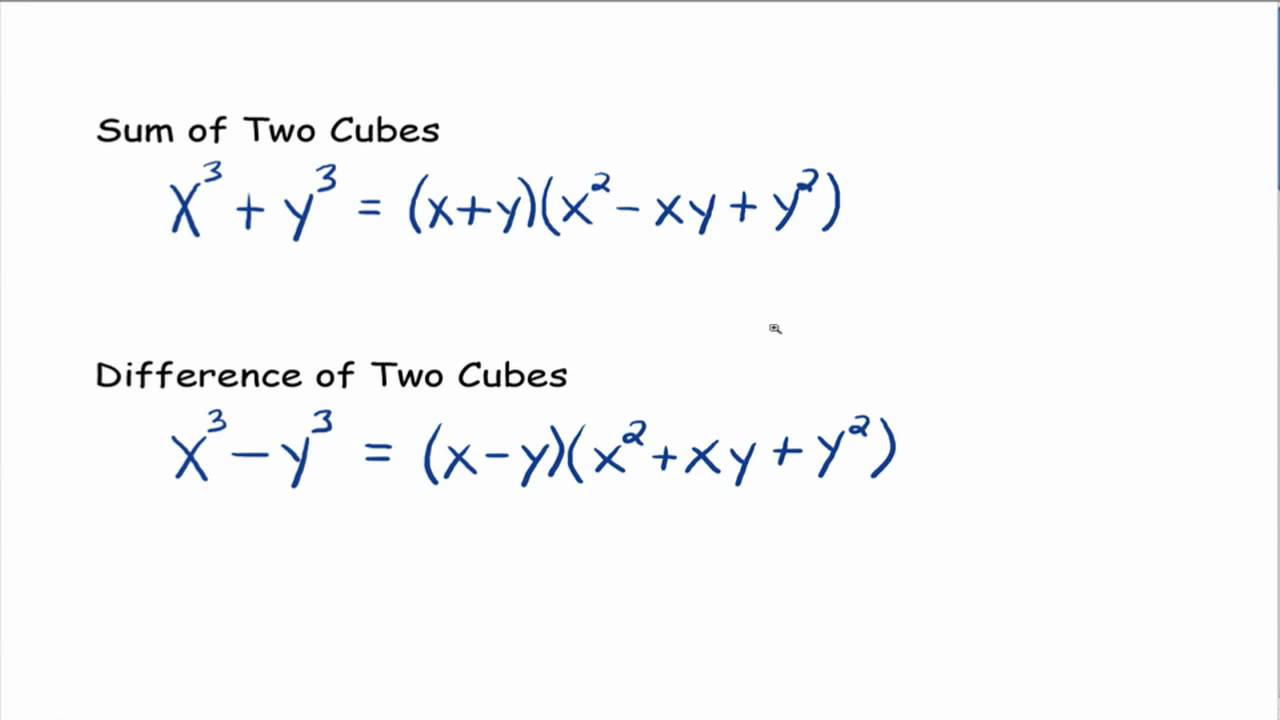When you encounter a binomial expression that doesn’t fit the pattern of a difference of squares, you may need to consider whether it’s a difference or sum of cubes. Recognizing and factoring these correctly is essential for simplifying polynomials.
1. Difference of Cubes
A difference of cubes is of the form a3−b3a^3 – b^3. This is factored using the following formula: a3−b3=(a−b)(a2+ab+b2)a^3 – b^3 = (a – b)(a^2 + ab + b^2)
2. Sum of Cubes
A sum of cubes follows the form a3+b3a^3 + b^3. To factor it, you use: a3+b3=(a+b)(a2−ab+b2)a^3 + b^3 = (a + b)(a^2 – ab + b^2)
Steps for Factoring a Cubic Difference or Sum
Let’s use the example 8×3+278x^3 + 27 to walk through the process:
Step 1: Look for a Greatest Common Factor (GCF)
Before doing anything else, always check if the terms in the binomial share a common factor. In this case, 8x38x^3 and 2727 don’t have a GCF, so we can move on to the next step.
Step 2: Check if it’s a Difference of Squares
You might think this binomial could be factored as a difference of squares, but the plus sign between the terms immediately rules this out.
Step 3: Determine if It’s a Sum or Difference of Cubes
The presence of a plus sign suggests that it may be a sum of cubes. Now, rewrite the terms as cubes: 8×3+27=(2x)3+(3)38x^3 + 27 = (2x)^3 + (3)^3
Since both terms are cubes, it confirms that this is a sum of cubes.
Step 4: Apply the Factoring Formula
Using the sum of cubes formula a3+b3=(a+b)(a2−ab+b2)a^3 + b^3 = (a + b)(a^2 – ab + b^2), replace aa with 2x2x and bb with 33:
(2x+3)((2x)2−(2x)(3)+(3)2)(2x + 3)\left((2x)^2 – (2x)(3) + (3)^2\right)
Step 5: Simplify
Now simplify the expression:
(2x+3)(4×2−6x+9)(2x + 3)(4x^2 – 6x + 9)
Step 6: Check for Further Factorization
Once you have factored the expression, always check if it can be simplified further. In this case:
- The binomial term 2x+32x + 3 won’t factor any further since it’s a first-degree binomial.
- The trinomial 4×2−6x+94x^2 – 6x + 9 doesn’t factor any further either.
Thus, your final factored form is:
(2x+3)(4×2−6x+9)(2x + 3)(4x^2 – 6x + 9)
Frequently Asked Questions (FAQs)
What’s the difference between a difference of cubes and a sum of cubes?
- A difference of cubes has the form a3−b3a^3 – b^3 and factors as (a−b)(a2+ab+b2)(a – b)(a^2 + ab + b^2).
- A sum of cubes has the form a3+b3a^3 + b^3 and factors as (a+b)(a2−ab+b2)(a + b)(a^2 – ab + b^2).
How do I recognize a cubic expression?
A cubic expression will have terms where the variables are raised to the power of three, such as x3x^3, 8x38x^3, or 2727 (which is 333^3).
Can I use the same factoring formula for both sum and difference of cubes?
No. The formulas are slightly different:
- Difference of cubes: a3−b3=(a−b)(a2+ab+b2)a^3 – b^3 = (a – b)(a^2 + ab + b^2)
- Sum of cubes: a3+b3=(a+b)(a2−ab+b2)a^3 + b^3 = (a + b)(a^2 – ab + b^2)
What happens if I forget to check for a GCF before factoring?
If you skip this step, you might end up with a factored form that isn’t fully simplified. Always check for a GCF first to ensure your final answer is as simple as possible.
How do I know when I’m done factoring?
After applying the sum or difference of cubes formula, check the resulting factors:
- If the binomial is first-degree (like 2x+32x + 3) and has no GCF, it’s already in its simplest form.
- For the trinomial, check if it fits other common factoring techniques (such as the difference of squares or quadratic formulas). If it doesn’t, you’re done.
Can a sum of cubes ever be factored further?
Generally, after applying the sum of cubes formula, the result is in its simplest form. However, always check for a possible GCF or other factoring methods just to be sure.




